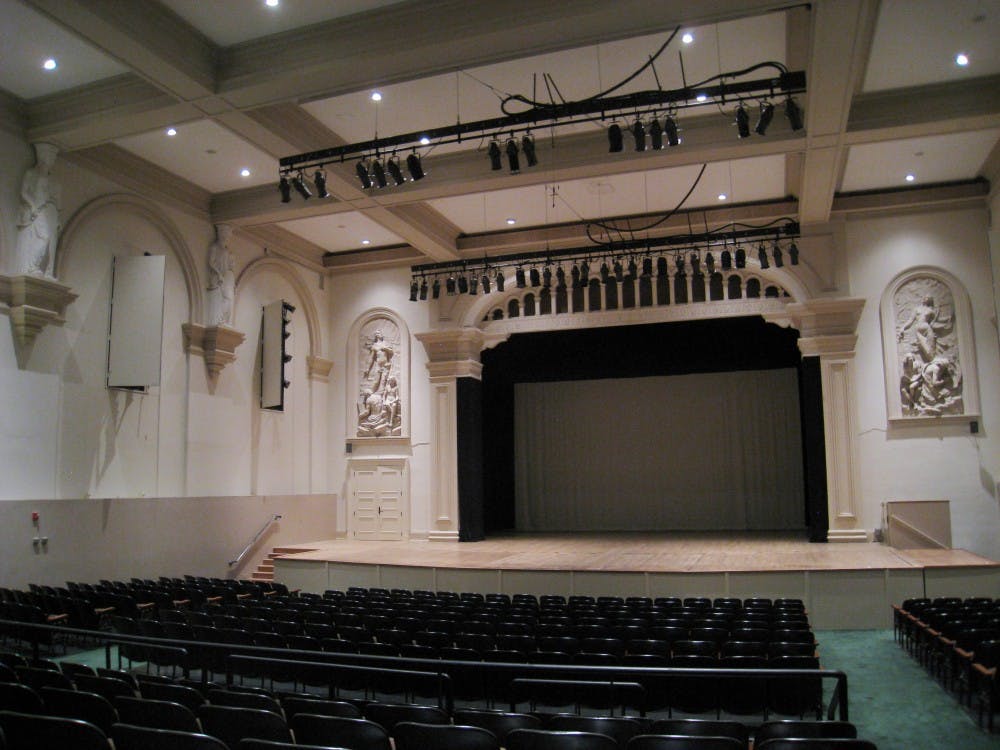Compared to ensembles like the full symphony orchestra and string quartet, the wind ensemble seems to be a less written-for group. Exceptions may include instances in which programs present notable pieces like Holst’s “First Suite” and “Second Suite” or Samuel Barber’s much-loved “Commando March,” but for all their merits, performances of these works remain infrequent.
However, this dissimilitude in popularity is by no means an index of relative competence, as the Peabody Wind Ensemble demonstrated on Saturday, March 30. The performers were more than adept at navigating rapid shifts in time signature and dynamics, all the while maintaining a general sense of technical finesse and unity. The concert ultimately made for a delightful evening of diverse programming and impressive sonic fireworks.
The first half of the concert featured William Schuman’s “George Washington Bridge” and Julie Giroux’s “Symphony No. 4: Bookmarks from Japan.” Following the intermission, the wind ensemble concluded with a performance of John Mackey’s “Wine-Dark Sea: Symphony for Band.”
“George Washington Bridge,” written in 1950, was inspired by the eponymous suspension bridge linking New Jersey with New York. Schuman wrote the piece as a tribute to its majestic appearance and the many times he has encountered the bridge on commutes.
“I have walked across it late at night when it was shrouded in god, and during the brilliant sunshine hours of midday. I have driven over it countless times and passed under it on boats. Coming to New York City by air, sometimes I have been lucky enough to fly right over it. It is difficult to imagine a more gracious welcome or dramatic entry to the great metropolis,” he wrote in the program’s notes.
Characterized by mercurial shifts in color and a Barber-esque sense of rhythm, “George Washington Bridge” is a majestic ode to transcendent aesthetic experiences. The piece was also notable for its elaborate polychordal harmonic devices evocative of Stravinsky’s famous “Symphonies of Wind Instruments” written almost 30 years prior, which was also scored for wind ensemble.
The Peabody Wind Ensemble delivered an explosive, vivacious interpretation of the piece. The brasses and woodwinds were well balanced and created robust, clear harmonies while also skillfully navigating delicate shifts in color.
The next piece by Julie Giroux, “Symphony No. 4: Bookmarks from Japan,” was somewhat more subdued than Schuman’s piece, but it was also more sophisticated in its choice of instrumentation.
“Symphony No. 4” pays homage to key figures in classical Japanese art such as Hiroshige Andō and Katsushika Hokusai. Consisting of six evocative movements — “I. Fuji-San - ‘Mount Fuji,’” “II. Nihonbashi - ‘Bridge Market,’” “III. The Great Wave off Kanagawa - ‘The Life of One Wave,’” “IV. Kinryu-zan Sensoji - ‘Thunder Gate,’” “V. Evening Snow at Kambara - ‘Light is the Touch’” and “VI. Hakone - ‘Drifting’” — the symphony is like an auditory tour of Japan’s major sights.
Though not quite as bombastic as “George Washington Bridge,” Giroux’s symphony nonetheless delivers its fair share of loud moments. From thunderous taiko-like percussion and the crashing of tam-tams, to fluttering cascades of pentatonic scales in the woodwinds and thunderous fanfares from the brass, “Symphony No. 4” is another composition that demonstrates the sonic potential of the wind ensemble.
The Peabody Wind Ensemble’s brass section had many chances to show off their power and duly delivered an impressively rich sound. The small-ensemble performance involving the piano, harp and flute at the beginning of movement V was also wonderfully executed.
The final piece of the night, John Mackey’s “Wine-Dark Sea: Symphony for Band,” was a fitting conclusion to an energetic set of performances in the first half. Based on episodes from Homer’s Odyssey, “Wine-Dark Sea” is deliberately programmatic.
In collaboration with his wife Abby, Mackey worked on setting music to several “highlight” moments in Homer’s epic.
“We had taken a similar approach with ‘Harvest,’ my trombone concerto about Dionysus, the Greek God of wine. Why not return to the Greek myths for this symphony? And since this story needed to be big (epic, even), I’d use the original, truly epic tale of Odysseus, as told thousands of years ago by Homer in The Odyssey,” he said as quoted in the program.
Wine-Dark Sea consists of three movements titled “I. Hubris,” “II. Immortal Thread, So Weak” and “III. The Attentions of Souls,” moving from fast to slow then fast again. The piece reflects Mackey’s proclivity for brass-heavy bursts of dissonant harmony, clashing tones and playful melodies that characterize his other wind-ensemble pieces like “High Wire” and “Xerxes.”
However, in the second movement, Mackey proves that he can also write with delicacy. It begins with a solo from the clarinet and harp, which is supposed to be evocative of Odysseus’ seven-year sojourn on Calypso’s island. It then builds up to a development involving the lower winds, which are later joined by the brass. The piece ends with a playful finale that begins with suspense and concludes with a bang.
The Peabody Wind Ensemble’s performance of Wine-Dark Sea was stimulating and well-paced; the instrumentalists followed the conductor well and made the best of the many dramatic shifts in dynamic and instrumentation within the piece.
As the audience rose to give a standing ovation concluding Wine-Dark Sea, I quickly left the concert hall to catch the bus, all the while filled with a renewed appreciation for the wind ensemble program at Peabody and for the wind ensemble repertoire as a whole.





